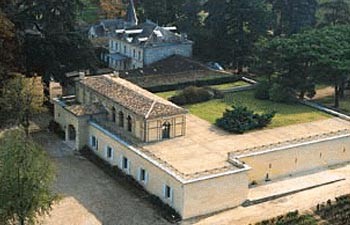John Brown has been a wine and food columnist in West Virginia since the 1980’s. His regular columns appear in the Charleston (WV) Gazette-Mail under the title Vines & Vittles.
The Greatest Bordeaux ever? I thought it was Zinfandel!
The estate of Château Cheval Blanc in St Emilion. Home of one of the greatest wines ever? From antique-wine.com. Bordeaux is perhaps the most storied region in all of winedom. Perched in southwestern France and close to the Atlantic Ocean, this famous appellation produces wine that is the benchmark upon which all great red wine, particularly cabernet sauvignon, is measured.
In 1855, the wines of Bordeaux were classified according to quality by a ranking that still exists today. The best of these wines are called "Grand Crus" and are categorized into five classifications or “growths.” The greatest are called “First Growths” and they include Chateau Lafite Rothschild, Ch. Latour, Ch. Mouton Rothschild (which was added in 1973), Ch. Margaux and Ch. Haut Brion.
Two other wines, Chateau Cheval Blanc and Chateau Petrus, were not rated in the 1855 classification, but are also considered First Growths. The thousands of Bordeaux wines not rated among the first five growths are called Crus Bourgeois, Crus Artisans, St. Emilion and Graves.
Bordeaux is a region that inspires great debate among wine lovers. Most recently, that discussion has focused on the stratospheric price of recent vintages, particularly those wines made in 2005. That vintage is considered great by wine critics around the world and, if you can afford them, the cream of the 2005 crop can range from several hundred to thousands of dollars a bottle. Since there are more than 7,000 Chateaux (wineries) in the Bordeaux region, it is possible to find an ample supply of good wines in the $20 to $50 a bottle range, but the ones with the best reputations are prohibitively expensive. And, while some of the lesser known Bordeaux are beginning to appear on wine shop shelves, most of the expensive wines have not arrived yet. In fact, most of the “best of the best” or First Growths, have been purchased as “futures” by well-heeled collectors who hope to get them at prices significantly less than when they hit the shelves later this year.
My experience with First Growths is limited and has not been particularly successful (with one notable exception which I’ll tell you about later). My problem has been discovering the optimum time to drink them. So far, each of the wines I’ve tasted has been too young and tannic, and has not reached full maturity. However, my experience with other highly classified wines has been, for the most part, wonderful.
Why? Well, the beauty of Bordeaux red for me is that it offers so much more complexity than single varietals such as cabernet sauvignon. I think Bordeaux succeeds because it is generally comprised of a proprietary blend of grapes (some combination of cabernet sauvignon, merlot, cabernet franc, petit verdot and malbec) that results in a style of wine from a particular producer that is pretty consistent from year to year.
Want a whopper? Go to Pauillac (where cabernet is the predominant grape). Prefer a richer, more refined style? Try the wines of St. Emilion or Pomerol (where merlot and cabernet franc are the main varietals). Many new world wineries, such as those in California, are making wines with similar Bordeaux-style blends ( called meritage wines), but the vast majority of producers remain committed to single varietals -- and usually cabernet sauvignon.. And that’s not necessarily bad. It’s just a different approach. So what about my one other-worldly experience with a First Growth Bordeaux? Well, it involves a pretty embarrassing moment for this wine “expert.” About 20 years ago, I attended a blind tasting of cabernet/Bordeaux wines at a friend's home. Among the wines our generous host uncovered at the conclusion of the event, was the '47 Cheval Blanc - which I had described to the assembled multitude as the "best zinfandel I have ever tasted."
After reading a great article on this spectacular wine recently in Slate Magazine ("The Greatest Wine on the Planet"), I don't feel quite so bad. In that piece, the author points to the intensity and opulence and almost Port-like quality of the wine. To this day, it still remains the best wine ever to cross these purple-stained lips!

